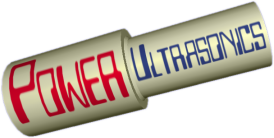Plastic welding is used for a huge variety of products ranging from blister packs, cartons and small consumer goods up to car fuel tanks and dashboards. It works by generating heat exactly where it is needed - at the interface between the components to be joined. The components are clamped between a vibrating sonotrode and a fixed mounting. Strangely, the vibrations are usually applied perpendicular to the contact surface, although much of this vibration may be converted to in-plane movement. This also has the advantage that the clamping pressure will keep the sonotrode in contact with the component - serrated surfaces are generally not required. Best results are achieved when the components are clamped close to the interface ("near-field" welding) but if this is not possible then the process can still work at a distance ("far-field").
Staking, or insertion, is a variation of this process in which a metal part (generally a threaded bush) is driven into a hole in a plastic component, which then solidifies around it to form a permanent join. This is a convenient method of producing strong tapped holes in a plastic part.
More information:
